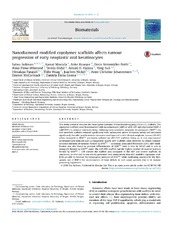Nanodiamond modified copolymer scaffolds affects tumour progression of early neoplastic oral keratinocytes
Suliman, Salwa; Mustafa, Kamal Babikeir Eln; Krueger, Anke; Steinmüller-Nethl, Doris; Finne-Wistrand, Anna; Osdal, Tereza; Osman, Amani Hamza Ali; Sun, Yang; Parajuli, Himalaya; Waag, Thilo; Nickel, Joachim; Johannessen, Anne Christine; McCormack, Emmet; Costea, Daniela Elena
Peer reviewed, Journal article
Published version

Åpne
Permanent lenke
https://hdl.handle.net/1956/15351Utgivelsesdato
2016-07Metadata
Vis full innførselSamlinger
Originalversjon
https://doi.org/10.1016/j.biomaterials.2016.04.002Sammendrag
This study aimed to evaluate the tumorigenic potential of functionalising poly(LLA-co-CL) scaffolds. The copolymer scaffolds were functionalised with nanodiamonds (nDP) or with nDP and physisorbed BMP-2 (nDP-PHY) to enhance osteoinductivity. Culturing early neoplastic dysplastic keratinocytes (DOKLuc) on nDP modified scaffolds reduced significantly their subsequent sphere formation ability and decreased significantly the cells' proliferation in the supra-basal layers of in vitro 3D oral neoplastic mucosa (3D-OT) when compared to DOKLuc previously cultured on nDP-PHY scaffolds. Using an in vivo non-invasive environmentally-induced oral carcinogenesis model, nDP scaffolds were observed to reduce bioluminescence intensity of tumours formed by DOKLuc + carcinoma associated fibroblasts (CAF). nDP modification was also found to promote differentiation of DOKLuc both in vitro in 3D-OT and in vivo in xenografts formed by DOKLuc alone. The nDP-PHY scaffold had the highest number of invasive tumours formed by DOKLuc + CAF outside the scaffold area compared to the nDP and control scaffolds. In conclusion, in vitro and in vivo results presented here demonstrate that nDP modified copolymer scaffolds are able to decrease the tumorigenic potential of DOKLuc, while confirming concerns for the therapeutic use of BMP-2 for reconstruction of bone defects in oral cancer patients due to its tumour promoting capabilities.
